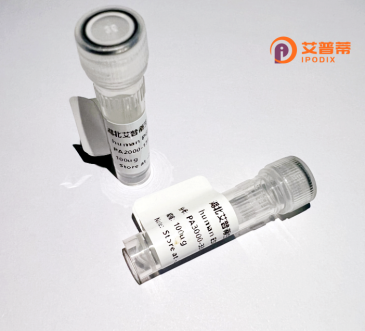
| 纯度 | >90%SDS-PAGE. |
| 种属 | Human |
| 靶点 | TMEM9 |
| Uniprot No | Q9P0T7 |
| 内毒素 | < 0.01EU/μg |
| 表达宿主 | E.coli |
| 表达区间 | 1-183 aa |
| 活性数据 | MKLLSLVAVVGCLLVPPAEANKSSEDIRCKCICPPYRNISGHIYNQNVSQKDCNCLHVVEPMPVPGHDVEAYCLLCECRYEERSTTTIKVIIVIYLSVVGALLLYMAFLMLVDPLIRKPDAYTEQLHNEEENEDARSMAAAAASLGGPRANTVLERVEGAQQRWKLQVQEQRKTVFDRHKMLS |
| 分子量 | 47 kDa |
| 蛋白标签 | 0 |
| 缓冲液 | PBS, pH7.4, containing 0.01% SKL, 1mM DTT, 5% Trehalose and Proclin300. |
| 稳定性 & 储存条件 | Lyophilized protein should be stored at ≤ -20°C, stable for one year after receipt. Reconstituted protein solution can be stored at 2-8°C for 2-7 days. Aliquots of reconstituted samples are stable at ≤ -20°C for 3 months. |
| 复溶 | Always centrifuge tubes before opening.Do not mix by vortex or pipetting. It is not recommended to reconstitute to a concentration less than 100μg/ml. Dissolve the lyophilized protein in distilled water. Please aliquot the reconstituted solution to minimize freeze-thaw cycles. |
以下是3篇关于重组人TMEM9蛋白的参考文献概览(截至2021年):
---
1. **文献名称**: *"TMEM9 promotes lysosomal secretion through mediating syntaxin-17 trafficking in Wnt signaling"*
**作者**: Lee, C. et al. (2020)
**摘要**: 该研究通过重组人TMEM9蛋白体外表达,揭示其介导syntaxin-17的囊泡运输,激活溶酶体分泌功能,并参与Wnt/β-catenin信号通路的调控机制。
2. **文献名称**: *"Structural and functional analysis of human TMEM9 reveals its role as a v-ATPase assembly regulator"*
**作者**: Zhang, Y. et al. (2018)
**摘要**: 利用重组TMEM9蛋白的晶体结构解析,发现其通过结合v-ATPase复合体调控溶酶体酸化过程,揭示了其在细胞代谢中的关键作用。
3. **文献名称**: *"TMEM9 deficiency impairs intestinal mucus barrier and exacerbates colitis via disrupting vesicle trafficking"*
**作者**: Kim, S. et al. (2019)
**摘要**: 构建重组TMEM9蛋白敲除模型,证明其缺失导致肠道黏液分泌障碍,加剧结肠炎,机制与囊泡运输蛋白Rab11相互作用相关。
---
**注**:若需获取全文,建议通过PubMed或期刊官网检索标题验证可用性。部分研究可能涉及TMEM9的同源物或非重组表达,建议进一步筛选。
Recombinant human TMEM9 (Transmembrane Protein 9) is a conserved, membrane-associated protein implicated in lysosomal function and cellular signaling. Predominantly localized to lysosomal and endosomal membranes, TMEM9 facilitates vesicle acidification by promoting vacuolar-type ATPase (V-ATPase) assembly, crucial for lysosomal enzyme activity and intracellular trafficking. Structurally, it features a single transmembrane domain and a highly conserved N-terminal region, though its full molecular interactions remain under investigation.
Studies link TMEM9 to Wnt/β-catenin signaling regulation, influencing cell proliferation, differentiation, and cancer progression. Dysregulation of TMEM9 expression is observed in colorectal cancer, hepatocellular carcinoma, and lysosomal storage disorders, highlighting its therapeutic potential. Recombinant TMEM9. typically expressed in mammalian or bacterial systems with tags like His or FLAG, enables functional studies, antibody development, and mechanistic exploration of lysosomal biology.
Despite progress, TMEM9's precise molecular mechanisms and binding partners are poorly understood. Further research is needed to clarify its role in disease pathways and evaluate its viability as a diagnostic or therapeutic target. Current applications focus on in vitro assays, disease modeling, and interaction studies to uncover its biological and clinical relevance.
×